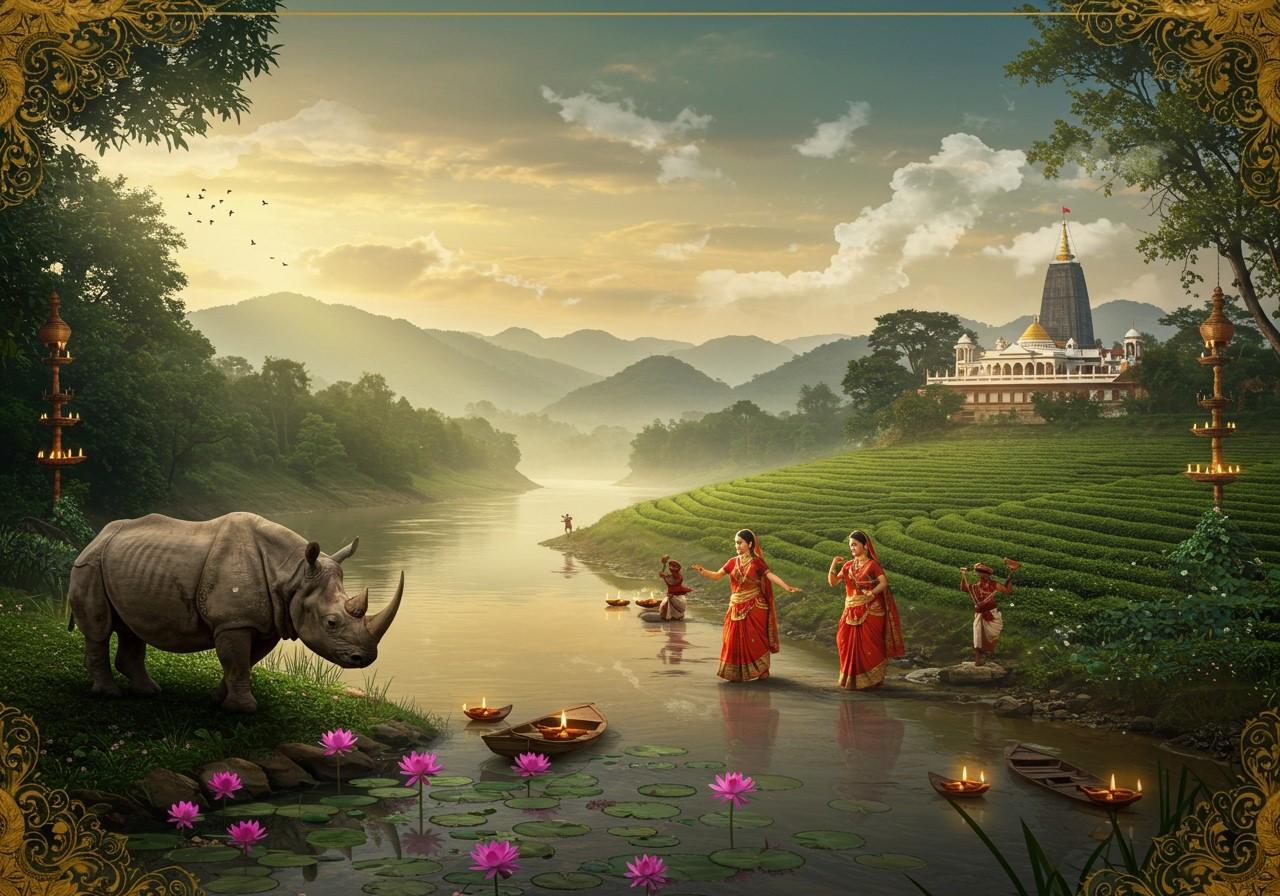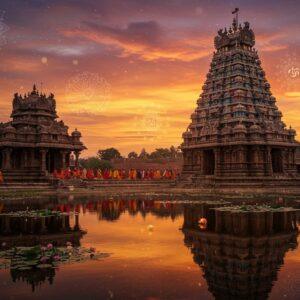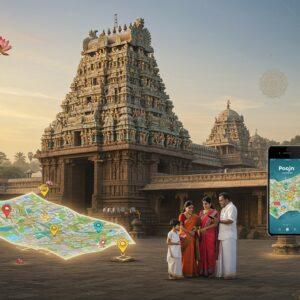
Assam, a state in Northeast India, is renowned for its rich cultural heritage, spiritual traditions, and natural beauty. It offers a mix of history, vibrant wildlife, sprawling tea gardens, and aromatic cuisine. Assam’s spiritual identity is rooted in various religious practices, including Hinduism, Shaktism, Vaishnavism, tribal animistic traditions, Islam, and Buddhism. The state is home to ancient temples and sacred rituals, making it an important spiritual hub.
Western Assam, in particular, beautifully intertwines nature, culture, and spirituality. This guide delves into the unique wildlife, cultural practices influenced by Hinduism, and prominent temples and pilgrimage sites that define the spiritual essence of Western Assam. Discover the rich tapestry of tradition and natural beauty that makes this region a must-visit for culturally rooted travelers.
Exploring the Western Assam Wildlife Division
Western Assam’s diverse wildlife thrives in its varied landscapes. Manas National Park, a UNESCO World Heritage Site, shelters rare species like the Assam roofed turtle, hispid hare, and golden langur. The park’s diverse flora and fauna add to its allure, making it a haven for nature enthusiasts.
Pobitora Wildlife Sanctuary boasts the highest density of Indian rhinoceroses, offering a unique opportunity to witness these magnificent creatures. The sanctuary plays a crucial role in rhino conservation efforts.
Deepor Beel, a Ramsar site, attracts birdwatchers with its rich avian diversity. Observe numerous bird species in their natural habitat, making it a paradise for bird enthusiasts.
The Brahmaputra River and its tributaries nurture the region’s wildlife, while community-driven initiatives champion sustainable tourism and conservation. Western Assam’s wetlands, grasslands, and forests support a unique ecosystem.
Western Assam’s Unique Cultural Practices Rooted in Hinduism
Hinduism deeply influences Western Assam’s cultural heritage. Bihu, the Assamese New Year, is celebrated with vibrant dance, music, and traditional feasts, showcasing the region’s joyous spirit.
The Ambubachi Mela at Kamakhya Temple, a unique festival, celebrates the goddess Kamakhya’s menstruation cycle. This event holds deep cultural and religious significance.
Traditional arts and crafts, such as Assam silk weaving and bamboo handicrafts, reflect the region’s artistic identity. These crafts are passed down through generations, preserving cultural heritage.
Folk music and dance, including the energetic Bihu dance and the narrative Ojapali, further enrich the cultural landscape. These art forms express the region’s stories and traditions.
Vaishnavism, through the teachings of Srimanta Sankardev, has profoundly shaped local culture and arts. His influence is evident in the region’s religious practices and artistic expressions.
Assamese cuisine, with its distinctive flavors and ingredients, is an integral part of the cultural experience. Traditional dishes prepared during festivals showcase the region’s culinary richness.
Prominent Temples and Pilgrimage Sites in Western Assam
Western Assam is dotted with spiritual landmarks. Kamakhya Temple, one of India’s most significant Shakti temples, draws pilgrims from across the country. Its historical and religious significance makes it a must-visit.
Umananda Temple, situated on Peacock Island in the Brahmaputra River, is dedicated to Lord Shiva. The temple’s unique location adds to its spiritual aura.
Basistha Ashram Temple, a serene hermitage dedicated to sage Basistha, offers a peaceful retreat for spiritual contemplation. The ashram’s tranquil atmosphere promotes inner peace.
The pilgrimage site of Hajo holds significance for Hinduism, Buddhism, and Islam, showcasing religious harmony. Temples like Hayagriva Madhava Temple and Powa Mecca coexist peacefully.
Doul Govinda Temple, dedicated to Lord Krishna, hosts the vibrant annual Doul Utsav. This festival is a major celebration in the region.
How Poojn.in Supports Your Spiritual Journey in Western Assam
Poojn.in, India’s leading online store for cultural and religious goods, offers a wide range of products to support your spiritual journey in Western Assam. Whether you’re visiting temples or performing puja at home, we have everything you need.
- For traditional Assamese rituals: Pure copper kalash sets, bell metal utensils (kanh), and cotton wicks (batti). These items are essential for performing various pujas and ceremonies according to Assamese traditions.
- For sacred offerings: Pure ghee from Indian cows, authentic incense sticks made with local ingredients, and traditional brass lamps (saaki). Enhance your spiritual practices with these high-quality offerings.
- For devotees of Lord Ganesha: Ganesha idols, modak molds, red hibiscus garlands, durva grass, and chandan powder. Honor Lord Ganesha with these specially curated items.
Visit poojn.in to explore our complete collection of puja items that support Western Assam’s spiritual traditions. All products are verified for authenticity and religious compliance.
Embrace the Essence of Western Assam
Western Assam offers a unique blend of nature, culture, and spirituality. From exploring Manas National Park to experiencing the vibrant Bihu festival and visiting the revered Kamakhya Temple, every experience resonates with the region’s rich heritage.
Discover the essence of Western Assam, where nature, culture, and spirituality intertwine to create an unforgettable journey.
FAQs on Exploring Western Assam
What wildlife can I encounter in Western Assam? Western Assam’s Wildlife Division is home to a diverse range of fauna, including elephants, tigers, rhinoceroses, and a plethora of bird species. This region offers a unique opportunity to witness these creatures in their natural habitats. Explore Manas National Park for a chance to spot rare species like the Assam roofed turtle, hispid hare, and golden langur.
How does Hinduism influence Western Assam’s culture? Hinduism has deeply shaped the cultural landscape of Western Assam. Festivals, rituals, traditional practices, art, dance, and music reflect Hindu beliefs and themes. The influence of Vaishnavism, particularly through the teachings of Srimanta Sankardev, is also prominent.
Which temples are prominent in Western Assam? Kamakhya Temple, Umananda Temple, Basistha Ashram Temple, and Doul Govinda Temple are among the prominent temples in Western Assam. These temples are significant pilgrimage sites and hold deep religious importance for locals and visitors alike. Explore the historical and architectural marvels of these sacred spaces.
Why is Kamakhya Temple so important? Kamakhya Temple is revered as one of the oldest and most significant Shakti Peethas in India. Dedicated to Goddess Kamakhya, it is a major center for Tantric worship and attracts devotees from all over the country. The unique Ambubachi Mela, celebrating the goddess’s menstruation cycle, further adds to the temple’s importance.
Can I find spiritual retreats in Western Assam? Yes, Western Assam offers a tranquil environment for spiritual seekers. Numerous ashrams and meditation centers provide opportunities for spiritual growth, meditation, and introspection. These retreats offer a peaceful escape from the hustle and bustle of daily life.
How can I experience local cultural practices? Immerse yourself in Western Assam’s culture by attending traditional festivals like Bihu and Durga Puja, visiting local villages, and participating in cultural programs. These experiences offer a glimpse into the region’s vibrant traditions, music, dance, and way of life.
When is the best time to visit for nature and wildlife? The ideal time to experience Western Assam’s nature and wildlife is from November to April. The weather during these months is pleasant, making it conducive for wildlife viewing and outdoor activities. Explore the national parks and sanctuaries during this period for optimal wildlife sightings.
Are there other pilgrimage sites besides temples? Yes, beyond temples, Western Assam boasts other significant pilgrimage sites. Hajo, sacred to Hindus, Muslims, and Buddhists, exemplifies religious harmony. The Hayagriva Madhava Temple, revered by both Hindus and Buddhists, is another notable pilgrimage destination.


